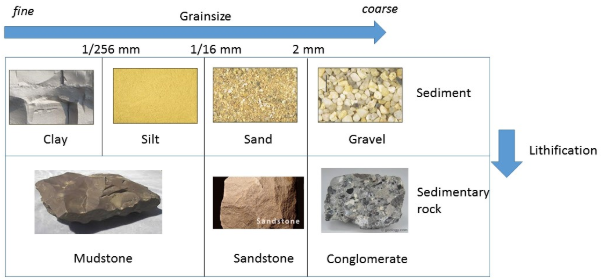This resource is designed for those learners looking to attempt and complete this course assessment tasks. We recommend you use these resources in partnership with the assessment task questions. Noting, if you require access or details about the assessment task.
The first of these resources is about Sedimentary rocks.
What is a sedimentary rock?
A sedimentary rock is any rock that has formed from sediment or processes at or near the Earth’s surface.
There are three types of sediment:
- Clastic sediment. The sediment is made of fragments of rocks breaking down and weathering at the Earth’s surface.
- Chemical sediment – formed by precipitated minerals, such as rock salt by evaporation of salty water in lakes of shallow seas.
- Biological sediment – made of or formed by organisms. Examples include coral reefs and coal made from plant debris.
When sediment is buried and has water percolating through it it will harden into rock (=lithification). When the sediment is a rock it is a sedimentary rock.
Clastic Sediment and Sedimentary Rocks
Clastic sediment and sedimentary rocks are described by the size of the fragments. These are names you may be familiar with,

Clastic sediment and sedimentary rocks are described by the size of the fragment
More information on describing clastic sediment and sedimentary rocks click
Biological and Chemical sediment and sedimentary rocks
Examples of some types of biological sediment and the rocks they form.
Example of chemical sediment: rock salt crystals (halite) forming by evaporation on the edges of a salty lake
This resource is designed for those learners looking to attempt and complete this course assessment tasks. We recommend you use these resources in partnership with the assessment task questions. Noting, if you require access or details about the assessment task.
The first of these resources is about Sedimentary rocks.
Sedimentary rocks
What is a sedimentary rock?
A sedimentary rock is any rock that has formed from sediment or processes at or near the Earth’s surface.
There are three types of sediment:
When sediment is buried and has water percolating through it it will harden into rock (=lithification). When the sediment is a rock it is a sedimentary rock.
Clastic Sediment and Sedimentary Rocks
Clastic sediment and sedimentary rocks are described by the size of the fragments. These are names you may be familiar with,
More information on describing clastic sediment and sedimentary rocks click
Biological and Chemical sediment and sedimentary rocks
Examples of some types of biological sediment and the rocks they form.
Example of chemical sediment: rock salt crystals (halite) forming by evaporation on the edges of a salty lake
Content is available under the
Creative Commons Attribution Share Alike License.
Privacy Policy | Authors